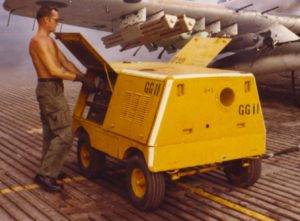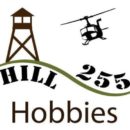 As I’ve mentioned before, researching many aspects of the Skyraider can quickly devolve into a byzantine process once you get too far past the low hanging fruit. It’s a jungle, really, with disregarded 900 pound gorillas thumbing their noses left right and center while everybody is busy sticking on bumble-toons all over the hood.
As I’ve mentioned before, researching many aspects of the Skyraider can quickly devolve into a byzantine process once you get too far past the low hanging fruit. It’s a jungle, really, with disregarded 900 pound gorillas thumbing their noses left right and center while everybody is busy sticking on bumble-toons all over the hood.
Case in point: what in Bertha’s bloomers are those little yellow carts (hereinafter known as “LYCs”) sitting right out there hooked up to Skyraiders in front of God and everybody, ubiquitous as they are mysterious and entirely unremarked by a single resource? You never see any modeler include them on displays or dioramas, yet they are a universal sine qua non of every parked A-1 squatting in every Vietnam Era revetment throughout the whole McNamarian nightmare.
There are no aftermarket kits available (well, I’m working on that) and they remain not only unidentified but entirely unnoticed in every single commercially available resource.
I researched those LYC’s for years, and I mean researched, and literally years. It became something of an obsession. No one knew what they were, where they came from or who made them. I drew blanks at the National Archives, likewise the Research Library of the USAF Museum as well as the National Air and Space Museum. The librarians there were diligent, helpful and courteous; they just couldn’t help me with any documentation even with photos in hand.
Before my retirement I occasionally flew with guys who had flown Skyraiders in SEA; I showed every one of them pictures of my LYC and to a man they would shrug and say “…oh, yeah, that’s the GPU…” (duh) but not one could remember what it was called or any designation at all. My own brother in law was an Army aircraft mechanic based at Chu Lai in 1969, and even he could only tell me the LYC looked familiar, but he had no idea what it was.
Of course it was a GPU (Ground Power Unit), I could see that for myself; gosh, I was a pilot and everything. The photo record also seemed to reveal some other information as well, to wit:
- They appear to be strictly a USAF piece of hardware; I have never been able to locate any picture of their use in naval service, though the VNAF did seem to have a few.
- They were not limited to just the Skyraider but do seem to be particular to piston engine, or more specifically, radial engine airplanes. I have found period photos of them plugged into T-28’s, C-123’s, C-41’s and C-47’s.
- I have never seen this particular LYC utilized with any turbine powered aircraft or smaller recip (horizontal opposed) such as a 0-1 or 0-2. This doesn’t mean they weren’t, it only means I haven’t found any pictures otherwise.
I did assay a scratch built attempt in 1/48 scale some year ago which you can see in the Projects Section. I sized it by extrapolating dimensions from a few dozen photographs measuring the LYC against know dimensions in the picture. It came out pretty close, as things turned out, but it’s not perfect. Right now, my little attempt is the only scale representation of this particular LYC I’ve run across so far; if anyone has done one, please share, I would love to see it.
And so things stood for quite a while. Among my later inquiries I got the idea to shoot a line over to Byron Huckee (spaddrvr@gmail.com) who runs my all-time favorite Skyraider website, Skyraider.org, and see what he knew about my LYC. Like all my other Spad driver acquaintances, Byron didn’t have an answer right off the top of his head. But he is as wired in as he is helpful and it wasn’t long before I got some leads; you know the “…hey, I know a guy who knows a guy…” kind of thing which can often lead to a pot of gold.
In this case pay dirt was right around the corner. Well, actually, not around the corner; it was actually at a little airport just south of Denver sitting behind a hangar. I am heartily sorry two computer crashes and a change of email accounts has caused us to lose touch in the three years since because I would sincerely like to give full credit where it is due; the owner of the carts could not have been more helpful or accommodating, he provided me with hand drawn measured drawing as well as detailed close up photos found over in the Reference Section. Sadly, all my records were electronic and have been lost but if by some odd chance he reads this blog, I hope he contacts me so I can edit and do justice by him for the help he gave.
In any case the LYC in question turns out to be a ground power unit built by the J.G. Brill Company of Philadelphia. I had been looking in all the wrong places; I had assumed it was built by someone like Hobart or one of the other aerospace equipment manufacturers, but…J.G. Brill? Whoda thunk? They built street cars!
Go figure.
Oddly enough, given I was trying to research the unit in light of its relation to the Skyraider, its own model designation is, as circumstance would have it, also A-1. The Little Yellow Cart is, then, a Brill A-1 GPU.
Armed with this nomenclature designation, I was able to go back to the Smithsonian and procure in short order a copy of the Air Force Maintenance Manual with every detail I ever could have wanted to know about my LYC.
I have since been working on reverse engineering the data uncovered to eventually produce a 3D model of the unit; so far so good. Stay tuned, it will appear here on the site in due time.
This, though, is the nature of research; months and years of drilling one dry hole after another, following leads which go nowhere, asking one silly question after another and learning to ignore the pitying sideways glances the less interested reserve for the bespectacled “geek”.
But, “eureka” is the payoff; like Mr. Miagi catching the fly with his chopsticks when there’s no one there to see, the little triumphs of enlightenment, the satisfaction of curiosity for its own sake has a savor all its own and can be easily relished in quiet solitude.
So, there you have it, the mystery of the LYC solved, next time you see a picture of a big Sandy loaded for bear, you’ll know what that little yellow piece of gear in the background is and will be able to impress, well, probably nobody; but you’ll know anyway, and sometimes, that’s enough.
Build long, and prosper.

